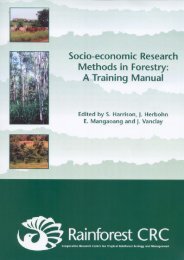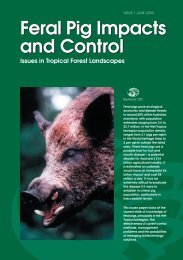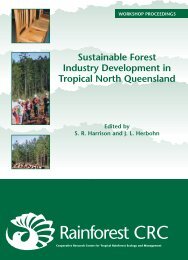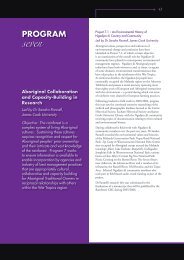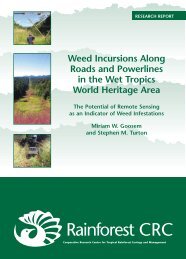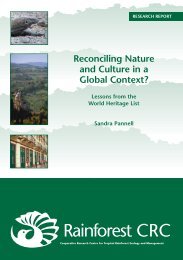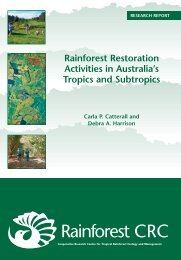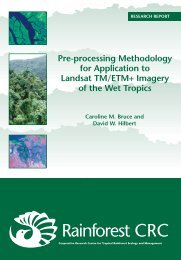S<strong>and</strong>ra PannellLike Marilyn Strathern, she also warns social scientists aga<strong>in</strong>st universalis<strong>in</strong>g our owncultural categories, “thus render<strong>in</strong>g ourselves deaf to alternative ways of structur<strong>in</strong>g theworld” (1980: 21).With the lessons of the Wet Tropics <strong>and</strong> Komodo National Park r<strong>in</strong>g<strong>in</strong>g <strong>in</strong> our ears, wherelocal people are either collapsed <strong>in</strong>to nature or excluded from it, MacCormack’s cautionarycomments lead us to ask the question: is there a way out of, or around, the nature-cultureparadigm? Perhaps, the answer to this question can be found <strong>in</strong> statements made byAborig<strong>in</strong>al people <strong>in</strong> North Queensl<strong>and</strong>.“NO DIFFERENCE, THEY BOTH TOGETHER, NATURE ANDCULTURE”If Hageners have no concept of nature <strong>and</strong> culture, then it appears that the TraditionalOwners of the Wet Tropics make no dist<strong>in</strong>ction between nature <strong>and</strong> culture. A commonobservation made by Aborig<strong>in</strong>al people <strong>in</strong> this region is that there is “no difference, they bothtogether, nature <strong>and</strong> culture”. Djabugay elder, Rhonda Brim, is referr<strong>in</strong>g here to the layer ofsymbolism <strong>and</strong> mean<strong>in</strong>g absent from the current list<strong>in</strong>g of the Wet Tropics for its naturalvalues. In situations like the wet tropical ra<strong>in</strong>forests of north-east Queensl<strong>and</strong>, the culturalpresence of hunter-gatherer people who “exploit the natural environment <strong>in</strong> a susta<strong>in</strong>ableway”, have “m<strong>in</strong>imal material culture” <strong>and</strong> largely “non-monumental lifestyles” (Fowler 2003:56) is not always apparent to Western ways of look<strong>in</strong>g <strong>and</strong> th<strong>in</strong>k<strong>in</strong>g about forest l<strong>and</strong>scapes.Yet, as Fowler remarks, the statement that “’there is noth<strong>in</strong>g there’ is <strong>in</strong> effect an<strong>in</strong>conceivable conclusion to expect from a serious exam<strong>in</strong>ation of any area of l<strong>and</strong>” (loc. cit.).The history of protected area gazettal <strong>and</strong> management <strong>in</strong> Australia, whether national parksor World Heritage properties, certa<strong>in</strong>ly po<strong>in</strong>ts to a perceptual (<strong>and</strong> obvious political) <strong>in</strong>abilityto see culture <strong>in</strong> nature (Smyth 2001), whether Indigenous or Anglo-Australian cultures. AsAnna Ts<strong>in</strong>g (2003) po<strong>in</strong>ts out, the scientific construction of nature, authorised by claims toobjectivity <strong>and</strong> neutrality, readily conceals the operation of Western cultural frameworks, aswell as those of m<strong>in</strong>ority groups.For Ra<strong>in</strong>forest Aborig<strong>in</strong>al people, like the Anangu Traditional Owners of Uluru Kata Tjuta, theidea of ‘nature’ as an autonomous doma<strong>in</strong> separated from culture is an anathema to theirbeliefs. As Rhonda Brim observes, “that’s whiteman identify<strong>in</strong>g <strong>and</strong> divid<strong>in</strong>g nature <strong>and</strong>culture. When we look at the World Heritage area we don’t just see trees, we see bushtucker, we don’t just see ra<strong>in</strong>forest, we see our home, our traditional country.”For Djabugay people, like other Ra<strong>in</strong>forest Aborig<strong>in</strong>al people, their traditional responsibility tocare for bulmba (‘country’) derives from the charter of Bulurru or the ‘Law’, established <strong>in</strong> the‘Dreamtime’ <strong>and</strong> subsequently, transmitted from generation to generation of Djabugaypeople (Duff<strong>in</strong> <strong>and</strong> Brim n.d.). In the words of two Djabugay women:All th<strong>in</strong>gs come from Bulurru – the sun, the moon <strong>and</strong> stars, the food we eat,the creatures of the world, the plants <strong>and</strong> trees, the ra<strong>in</strong>, the very l<strong>and</strong> itself.We ourselves come from Bulurru. Bulurru is the good spirit that protects life<strong>and</strong> Law (Duff<strong>in</strong> <strong>and</strong> Brim n.d.: 5).As these comments <strong>in</strong>dicate, Bulurru is acknowledged as the source of all life forms, naturalphenomena, social customs, subsistence practices, <strong>and</strong> cultural knowledge, which comprise<strong>and</strong> <strong>in</strong>form the world <strong>in</strong>habited by Djabugay people. In this sense, Bulurru providesDjabugay people with their “plan of life”, as the anthropologist, W. E. H. Stanner, oncedescribed the role of the Dream<strong>in</strong>g <strong>in</strong> Aborig<strong>in</strong>al society (Stanner 1963: 10).For the Traditional Owners of the Wet Tropics, country is regarded as a conscious entity thatgenerates <strong>and</strong> responds to their actions. As a counterpo<strong>in</strong>t to conservationist views of72
<strong>Reconcil<strong>in</strong>g</strong> <strong>Nature</strong> <strong>and</strong> <strong>Culture</strong> <strong>in</strong> a <strong>Global</strong> <strong>Context</strong>?Lessons from the World Heritage Listwilderness as un<strong>in</strong>habited spaces, Deborah Bird Rose speaks of country as “a liv<strong>in</strong>g entitywith a yesterday, today <strong>and</strong> tomorrow, with a consciousness <strong>and</strong> a will towards life” (1996: 7-8). This is a part of what Traditional Owners mean when they speak of a “liv<strong>in</strong>g” culturall<strong>and</strong>scape.Judg<strong>in</strong>g by the actions of the Australian Government <strong>and</strong> the World Heritage Committee,however, it seems that non-Aborig<strong>in</strong>al people <strong>in</strong>terpret statements about ‘liv<strong>in</strong>g l<strong>and</strong>scapes’<strong>and</strong> the togetherness of nature <strong>and</strong> culture to mean that Indigenous people are ‘one withnature’ <strong>in</strong> an evolutionary display of ecological relicts. This is certa<strong>in</strong>ly not the outcome<strong>in</strong>tended by Traditional Owners <strong>in</strong> the lead up to the nom<strong>in</strong>ation of the wet tropicalra<strong>in</strong>forests. While not entirely reject<strong>in</strong>g the proposition that Aborig<strong>in</strong>al people are ‘one withnature’, Traditional Owners are not, on the other h<strong>and</strong>, advocat<strong>in</strong>g for their <strong>in</strong>clusion with<strong>in</strong>some supra-category of culture, although their push for the renom<strong>in</strong>ation of the Wet Tropicsas a cultural l<strong>and</strong>scape could easily be read <strong>in</strong> these terms. What is clear, however, is thatthe Indigenous idea of ‘no difference between nature <strong>and</strong> culture’ is often <strong>in</strong>voked byAborig<strong>in</strong>al people to signal a history of cultural difference.Aborig<strong>in</strong>al cultural self-representations both challenge <strong>and</strong> embrace the commonly held viewof culture as fixed, uniform <strong>and</strong> unchang<strong>in</strong>g. As Cowan <strong>and</strong> her colleagues po<strong>in</strong>t out,Indigenous people’s appropriation of essentialist views of culture often jo<strong>in</strong>s together “an<strong>in</strong>terest <strong>in</strong> cultural renaissance with the political constra<strong>in</strong>ts of a society will<strong>in</strong>g to recognizeclaims on the basis of cultural authenticity <strong>and</strong> tradition” (2001: 42). While present<strong>in</strong>g culture<strong>in</strong> these terms may be politically effective <strong>in</strong> certa<strong>in</strong> contexts, <strong>in</strong> other situations it may denythe <strong>in</strong>teractive <strong>and</strong> <strong>in</strong>ventive nature of Aborig<strong>in</strong>al social constructs <strong>and</strong> actions. As LisaMeekison po<strong>in</strong>ts out, the ‘boomerang-throw<strong>in</strong>g’ image of Aborig<strong>in</strong>al culture “tends to re<strong>in</strong>forcewhat non-Indigenous people th<strong>in</strong>k about Indigenous people rather than what the latter th<strong>in</strong>kabout themselves’ (2000: 11). While there is no deny<strong>in</strong>g the fact that Aborig<strong>in</strong>al culturalidentities are often turned <strong>in</strong>to marketable commodities for tourist consumption or reduced tostereotypical images <strong>in</strong> the media, contemporary Indigenous representations <strong>and</strong> forms ofcommunication po<strong>in</strong>t to more dynamic <strong>and</strong> <strong>in</strong>novative processes at work. Appropriat<strong>in</strong>g newtechnologies <strong>and</strong> draw<strong>in</strong>g upon the <strong>in</strong>ter-connectedness offered by an <strong>in</strong>creas<strong>in</strong>glyglobalised world, these new cultural forms are often used to revivify “local languages,traditions <strong>and</strong> histories, <strong>and</strong> [articulate] community identity <strong>and</strong> concerns” (G<strong>in</strong>sburg 2000:30). In this sense we see how Aborig<strong>in</strong>al traditions can serve as both “a means <strong>and</strong>measure of <strong>in</strong>novation” (Sahl<strong>in</strong>s 2000: 512).In light of these comments, we can conclude, along with Arjun Appadurai (1996: 12-13), thatit is perhaps more useful to th<strong>in</strong>k of culture as a “heuristic device” to talk about difference,than to focus upon the noun form of culture, so often regarded as an object, th<strong>in</strong>g orsubstance. Rather than try<strong>in</strong>g to def<strong>in</strong>e what culture or nature is or is not, a more <strong>in</strong>terest<strong>in</strong>gexercise <strong>in</strong>volves look<strong>in</strong>g at the “relationship between the word <strong>and</strong> the world” (Appadurai1996: 51). Put another way, the <strong>in</strong>vocation of culture <strong>and</strong> nature is a far more <strong>in</strong>terest<strong>in</strong>garea of <strong>in</strong>vestigation than its def<strong>in</strong>ition.In the post-list<strong>in</strong>g period, it is clear that nature <strong>and</strong> culture constitute the small-arms fire <strong>in</strong> thestruggle by Traditional Owners to renom<strong>in</strong>ate the World Heritage Area as a “liv<strong>in</strong>g[Indigenous] cultural l<strong>and</strong>scape” (WTMA 2005: 1). As evident <strong>in</strong> the open<strong>in</strong>g sections of thisreport, this is also a struggle about the “appropriation of symbols, a struggle over how thepast <strong>and</strong> present shall be understood <strong>and</strong> labelled, a struggle to identify causes <strong>and</strong> assessblame, a contentious effort to give partisan mean<strong>in</strong>g to local history” (Scott 1985: xvii). In theoften lively exchanges which characterise this struggle, it is apparent that nature <strong>and</strong> cultureare also key terms <strong>in</strong> the discourse <strong>and</strong> practices associated with the day-to-daymanagement of the two World Heritage areas <strong>in</strong> North Queensl<strong>and</strong>, namely, the Wet Tropics<strong>and</strong> the Great Barrier Reef. For example, nature <strong>and</strong> culture form <strong>in</strong>fluential terms ofreference among the <strong>in</strong>ternationally recognised members of the science community, who73




